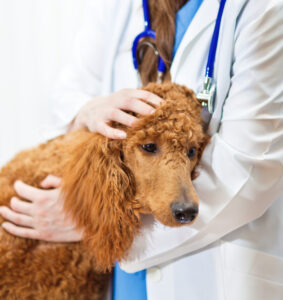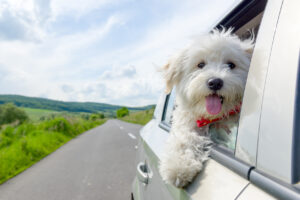Are you considering moving to a new home or apartment? According to mental health experts, moving is number three on the list of top five stressful situations life can bring. Though moving to a new home or city can be exciting, it creates stress in your life by bringing disruption to your normal routine. Imagine if you are a cat or dog. Your only requirements are food, water, a warm bed, and a scratch or two behind the ears each day. Our pets are creatures of habit. Placing their water bowl in a different spot can cause them stress. Moving to entirely new surroundings can incite major stress, perhaps even a freak out or two. We want to help make moving less stressful for you and your pet. By spending a little extra time planning, you will be better prepared and avoid some of the stress of moving.

Step one is organizing your paperwork. If you are moving down the block or within your current city limits, you don’t need to worry about travel documents, forms, or paperwork. However, if you are crossing state lines or moving to another country, you should get your pet’s records in order. Find out what documents you will need for your pet to be safely transported. A health certificate is required in most countries and some states, such as Hawaii. If you are traveling by plane, airlines will require one too. A health certificate or certificate of veterinary inspection (CIV) must be signed by a veterinarian. It is important to keep in mind, a signed health certificate is only good for 30 days.
Most countries and some states will require your pet to be quarantined for a certain period of time. It will be important to complete some research to familiarize yourself with the regulations which exist for your destination. A great resource is Pettravel.com which offers particulars on Airline pet policies, pet travel information, pet friendly hotels, and other relevant details about pet travel.
If your pet is microchipped, don’t forget to contact the microchip provider to update your new address. Contact your veterinarian’s office if you don’t have your pet’s microchip records. They can provide you with the necessary information you need to update your personal information. This is important and will ensure your pet can be safely located should he or she become lost.

If your move requires you to transport your pet by plane, you should contact the airline direct before you book your flight. Each airline has different requirements so it is important to educate yourself and gather as much information as possible. Being informed will prevent unnecessary worry and help reduce your stress. Another consideration is pet insurance. If your travel itinerary includes anywhere in the United States or Canada, pet insurance will cover any emergencies.
Call your veterinarian and make an appointment for your pet if you are moving far away. Your veterinarian should be well versed on health certificate requirements. They can also offer advice about motion sickness prevention. Be sure and fill any. necessary prescriptions, update vaccines, and request copies of your pet’s records.

When it comes to packing for your upcoming move, remember our pets are creatures of habit. Any disruption in their routine can cause them to become stressed. Try your best to keep their daily routine as regular as possible. Letting your pets see and be around the boxes you are packing may help them feel less anxious. If your cat goes or stays outdoors, consider bringing them indoors while packing. Some cats can become scared and refuse to come inside.
Another proactive approach to lessening your pet’s stress during a move, is to place your pet in their pet carrier to help them become familiar with it and get more comfortable. An enticement to help encourage your pet to go in their carrier, such as a favorite toy or treat, may help make it easier on them.
Does your pet only take a car ride when it’s time for their veterinary check-up? If you answered yes, consider taking them on more frequent short car rides before your move. Doing so may help reduce their anxiety and make it easier for them on moving day.

Another suggestion is to board your pet on the day you are moving in to your new home. This may help reduce their stress and provide them safety and security. Moving requires a lot of our attention. Where to put this box or that piece of furniture. It is chaotic, stressful, and could create unsafe conditions for your pet. It also means various people making lots of trips inside and outside. A door mistakenly left open, or an accidental kick from someone carrying a large box which obstructs their view, can be potentially harmful for your pet. You will feel better knowing your pet is safely being cared for in a boarding kennel. Less worry about your pet’s well being means less stress for you.
If your move requires a long road trip, remember to pack your pet’s favorite food, water, disposable plastic bags, a favorite toy, and plenty of extra towels in case of an accident. Consider putting one of your favorite t-shirts or sweatshirts in your pet’s carrier. Your familiar scent will be a calming influence on your pet.

If your long drive requires an overnight stay, research pet friendly hotels along your travel route. Always call the hotel directly to make sure your pet is indeed welcome. Always better to be safe than suddenly having to scramble to find another hotel at the last minute. Another important consideration is to be aware of your pet’s safety once inside your hotel room. It is not uncommon for a pet to try and escape by bolting for the door. Be diligent, mindful, and prepared!
We’ve all heard horror stories of air travel pet catastrophes. If you must travel by plane with your pet, there are several steps you can take to make it as safe as possible for your pet. These steps include: scheduling a direct flight; traveling on the same flight as your pet; never shipping brachycephalic animals such as Pekingnese dogs, bulldogs, or Persian cats in a plane’s cargo hold; choosing flights that best accommodate temperature extremes; making sure your pet’s collar is appropriately tight and can’t get caught on doors; affixing complete identification tags to your pet’s collar which includes all of your contact information; avoiding air travel during holidays and other busy travel times, as this will reduce the possibility your pet will undergo rough handling; labeling your pet’s carrier with all of your identifying information in case your pet becomes lost.
Make sure your new home is a hospitable environment for your pet. Are there toxic plants in the garden? Look for nooks and crannies where your cat could hide or escape to the outside.
Don’t forget to bring your pet’s familiar objects including their food and water bowls, litter box, pet bed, or scratching post. Place them in the same room where they were located in your old home. If their water bowl was in the kitchen of your old home, place it in the kitchen of your new one.
 Another important factor to consider when moving is your own stress level. Remember our pets are sentient beings. They can feel our stress and anxiety so its important to be mindful of this. When things feel out of control, take a minute for yourself to simply breathe in and out. Find something to help yourself ease into a calm state of being so your pet can feel calm too.
Another important factor to consider when moving is your own stress level. Remember our pets are sentient beings. They can feel our stress and anxiety so its important to be mindful of this. When things feel out of control, take a minute for yourself to simply breathe in and out. Find something to help yourself ease into a calm state of being so your pet can feel calm too.

